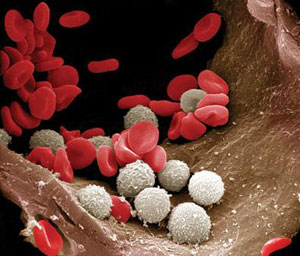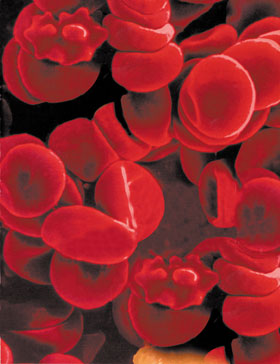 The 25 trillion or so small red cells in the human body never cease carrying their loads. These cells, known as erythrocytes, travel all through the body inside the veins and arteries, carrying oxygen or carbon dioxide. However, these cells need a special structure in order to be able to carry a substance. For example, for a cell to carry oxygen, the most ideal shape for it is to be flat. This increases the cell’s surface area and facilitates contact with the oxygen molecules.
The 25 trillion or so small red cells in the human body never cease carrying their loads. These cells, known as erythrocytes, travel all through the body inside the veins and arteries, carrying oxygen or carbon dioxide. However, these cells need a special structure in order to be able to carry a substance. For example, for a cell to carry oxygen, the most ideal shape for it is to be flat. This increases the cell’s surface area and facilitates contact with the oxygen molecules.
Indeed, the shape of the erythrocyte is reminiscent of a round, flat cushion, whose shape permits the greatest possible surface contact with the oxygen atom.
Under normal circumstances, some 2.5 million erythrocytes are produced in the body every second. It’s vitally important that the number of erythrocytes be regulated. A rise in their number for whatever reason—a reduction in body temperature, for instance—can lead to serious problems. When there is an excessive drop in body temperature the number of erythrocytes remains the same, although the blood fluid decreases. The viscosity of the blood is reduced, as the number of erythrocytes increases in terms of units per volume. This can lead to congestion in the veins, obliging the heart to work harder. It’s therefore of vital importance for the number of erythrocytes to be regulated.
It is not enough for the body’s transportation system for red blood cells to be flat. Erythrocytes that carry oxygen would be pointless if they could not offer it to the cells in a usable manner. The cells of the body require molecules to bind oxygen to them—molecules that must combine with the oxygen in the ideal manner, in a three-dimensional form, and carry the oxygen safely. However, they must not bind too tightly to the oxygen, and when they arrive at the cell to which they will release the oxygen, they must separate from it with no difficulty. In short, in order for the oxygen to be transported and used where necessary, a very special molecule with a most particular creation is needed. That molecule is hemoglobin, which gives the erythrocyte—and thus, the blood itself—its red color.
Since hemoglobin performs two entirely separate functions, it has been described as an extraordinary molecule.
As hemoglobin deposits carbon dioxide in the lungs, it takes up oxygen and moves from there to the muscles, which oxidize nutrients and produce carbon dioxide. When the hemoglobin reaches the muscles, it carries out a reverse procedure, depositing oxygen and taking up carbon dioxide—all in a seemingly conscious and disciplined manner.
The wisdom in the Erythrocyte’s shape As already stated, the erythrocyte cell is shaped like a flat, round cushion. That ideal shape increases the cell’s surface area and facilitates contact with oxygen. In the event that this shape is deformed, exceedingly serious diseases result. In sickle cell anemia, the erythrocytes contain an abnormal form of hemoglobin known as hemoglobin S. When deprived of oxygen, this hemoglobin breaks down into elongated crystals within the erythrocyte, which crystals lengthen the cell, giving it a sickle-like shape. Since the erythrocytes have assumed a crescent-like form, the passage of oxygen from the blood to the tissues is made more difficult. This leads to an oxygen deficiency and increased production of sickle-shaped red cells. The condition can reach fatal proportions within a few hours.
As already stated, the erythrocyte cell is shaped like a flat, round cushion. That ideal shape increases the cell’s surface area and facilitates contact with oxygen. In the event that this shape is deformed, exceedingly serious diseases result. In sickle cell anemia, the erythrocytes contain an abnormal form of hemoglobin known as hemoglobin S. When deprived of oxygen, this hemoglobin breaks down into elongated crystals within the erythrocyte, which crystals lengthen the cell, giving it a sickle-like shape. Since the erythrocytes have assumed a crescent-like form, the passage of oxygen from the blood to the tissues is made more difficult. This leads to an oxygen deficiency and increased production of sickle-shaped red cells. The condition can reach fatal proportions within a few hours.
Apart from such diseases, the shape of the erythrocyte is the same in everyone. Thanks to that shape, they can easily carry oxygen to wherever it’s needed. The fact that the erythrocytes are round and flat in everyone who has ever lived, or will live in future, can never be explained in terms of coincidences. Allah has perfect knowledge of all, and sets out and arranges everything down to the very finest detail. Great is the glory of Allah, the Lord of the worlds.
TOPICS
CavourVaticanSocialismIlluminationFrench RevolutionConvertSabbateanJacobinismMasonic MediaPolitical ZionismYoung TurkThe Committee of Union and ProgressAbdulhamidAnti-NaziWorld Zionist Organization Nuremberg LawsMussoliniWorld War IAdolf EichmannGoyimThe Rothschild DynastyThink-ThankCFRRockefellerCold WarStalinOctober RevolutionSoviet UnionBilderbergVietnamAIPACLobbyfairSoutheastGreeceNew World OrderRed Seageopoliticsveterantaxcustoms2023antelopebullEurasia Islam CouncilNobel PrizeHospitalSocial Security InstitutionAli BabacanTurgut OzalassassinationGaffar OkkanMuhsin YazıcıoğluRosetta NebulaAstronomyRoseDamascus Sermonnuclear weaponIyad AllawiNautilussubmarinediving cellAli BardakogluTelevisionTelevoleCanakkale


